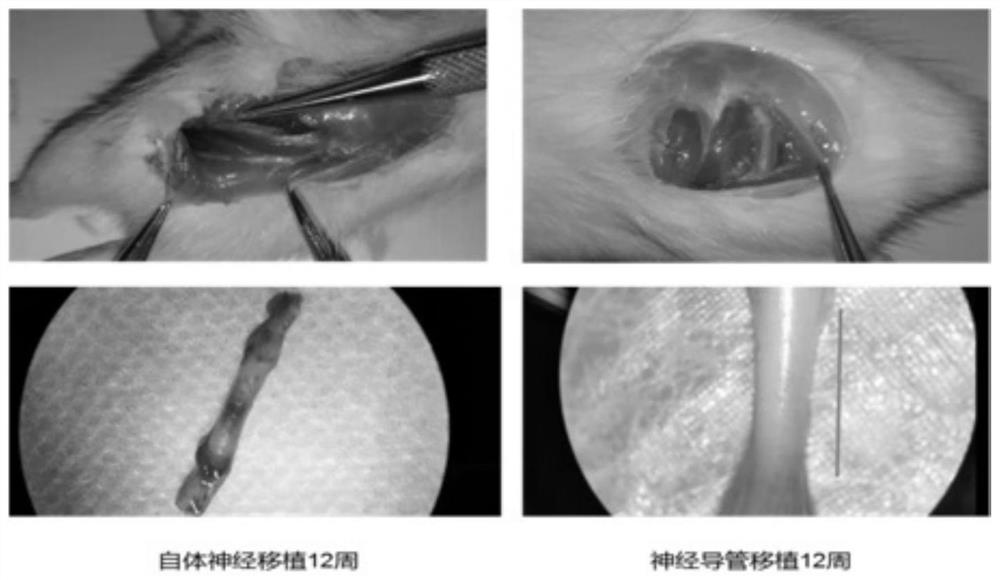Nerve-induced repair catheter stent as well as preparation method and application thereof
A catheter stent, nerve technology, applied in the direction of prosthesis, tissue regeneration, additive processing, etc., can solve the problems of damage to the donor site, source limitation, poor mechanical strength, etc., to increase the electrical conductivity and induce nerve repair. Effect
- Summary
- Abstract
- Description
- Claims
- Application Information
AI Technical Summary
Problems solved by technology
Method used
Image
Examples
Embodiment 1
[0027] A preparation method for nerve induction repair catheter stent, comprising the steps of:
[0028] (1) First, add 1.6g of polylactic acid into 10mL of dichloromethane, ultrasonically disperse and dissolve to obtain a solution, then add 0.2mL of an aqueous dispersion of reduced graphene oxide with a concentration of 0.1g / mL to the solution, and stir evenly Finally, a 3D printer is used to prepare an outer tube support, which is a circular tube structure with an inner diameter of 2mm, an outer diameter of 2.5mm, and a length of 10mm;
[0029] (2) Take 10 mL of the decellularized extracellular matrix solution with a concentration of 1.5 wt%, and then add 0.16 g of methacrylic anhydride gelatin (GelMA) to disperse it in the decellularized extracellular matrix solution, and control the temperature to 4° C. Add 6uL of mouse nerve growth factor, add 0.48mg of photocuring agent HMPP 1173 in a light-proof environment, and use a 3D printer to prepare a cylindrical inner-filled sca...
Embodiment 2
[0032] A preparation method for nerve induction repair catheter stent, comprising the steps of:
[0033] (1) First, add 1.8g of polylactic acid into 10mL of dichloromethane, ultrasonically disperse and dissolve to obtain a solution, then add 0.2mL of an aqueous dispersion of reduced graphene oxide with a concentration of 0.1g / mL to the solution, and stir evenly Finally, a 3D printer is used to prepare an outer tube support, which is a circular tube structure with an inner diameter of 2.1 mm, an outer diameter of 2.5 mm, and a length of 20 mm;
[0034] (2) Take 10 mL of the decellularized extracellular matrix solution with a concentration of 1.5 wt%, and then add 0.20 g of methacrylic anhydride gelatin (GelMA) to disperse it in the decellularized extracellular matrix solution, and control the temperature to 4° C. Add 10 uL of mouse nerve growth factor, add 0.60 mg of photocuring agent HMPP 1173 in a light-proof environment, and use a 3D printer to prepare a cylindrical inner-fi...
Embodiment 3
[0037] A preparation method for nerve induction repair catheter stent, comprising the steps of:
[0038] (1) First, add 2.0g of polylactic acid into 10mL of dichloromethane, ultrasonically disperse and dissolve to obtain a solution, then add 0.2mL of an aqueous dispersion of reduced graphene oxide with a concentration of 0.1g / mL to the solution, and stir evenly Finally, a 3D printer is used to prepare an outer tube support, which is a circular tube structure with an inner diameter of 2.1 mm, an outer diameter of 2.5 mm, and a length of 20 mm;
[0039] (2) Take 10 mL of the decellularized extracellular matrix solution with a concentration of 1.5 wt%, then add 0.16 g of methacrylic anhydride gelatin (GelMA) to lyophilize the solid and disperse it in the decellularized extracellular matrix solution, and control the temperature at Add 10uL of mouse nerve growth factor at 4°C, add 0.48mg of photocuring agent IRGACURE 2959 in a light-proof environment, and use a 3D printer to prepar...
PUM
| Property | Measurement | Unit |
|---|---|---|
| length | aaaaa | aaaaa |
| diameter | aaaaa | aaaaa |
| concentration | aaaaa | aaaaa |
Abstract
Description
Claims
Application Information
 Login to View More
Login to View More - R&D
- Intellectual Property
- Life Sciences
- Materials
- Tech Scout
- Unparalleled Data Quality
- Higher Quality Content
- 60% Fewer Hallucinations
Browse by: Latest US Patents, China's latest patents, Technical Efficacy Thesaurus, Application Domain, Technology Topic, Popular Technical Reports.
© 2025 PatSnap. All rights reserved.Legal|Privacy policy|Modern Slavery Act Transparency Statement|Sitemap|About US| Contact US: help@patsnap.com

